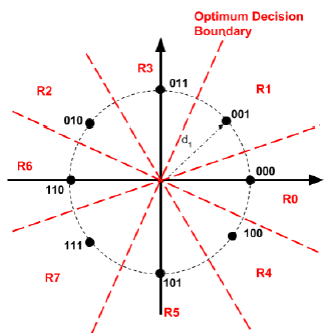I will borrow the 8PSK constellation diagram and bit-labeling used by the OP and also the names $R_1$ through $R_8$ of the 8 decision regions, but not the meanings (probabilities) used by the OP in his explanations of $R_1$ through $R_8$. That is, if the observation $(X,Y)$ lies in $R_i$, it is demodulated/decoded into the three bits that label the constellation point in the region $R_i$.
The unstated (but standard) assumptions are that we are looking at 8PSK signaling on an AWGN channel with two-sided power spectral density $\frac{\mathscr N_0}{2}$ and thus the 8 constellation points lie on a circle of radius $\sqrt{\mathscr E_s} = \sqrt{3\mathscr E_b}$ centered at the origin. Here $\mathscr E_s$ is the received energy per symbol and $\mathscr E_b$ the received energy per bit. Conditioned on which symbol has been transmitted, the receiver observation is $(X,Y)$ where $X$ and $Y$ are independent Gaussian random variables with variance $\frac{\mathscr N_0}{2}$ and mean point the constellation point corresponding to the given transmitted signal. Put another way, the joint distribution of $X$ and $Y$ has circular symmetry about the mean point $(\mu_X, \mu_Y)$, and it is a standard result in signal space theory that the probability that $(X,Y)$ lies on the other side of a straight line is $Q\left(\dfrac{d}{\sqrt{\mathscr N_0/2}}\right)$ where $d$ is the distance of the line from the mean point.
There are three different bit error events whose probabilities that we need to calculate: for $i=1,2,3$, $E_i$ is the event that the $i$-th bit is in error. These events are not independent, nor do they have identical probabilities.
Analysis for $E_1$: Suppose that $000$ is transmitted. Then, looking at the borrowed diagram above, we see that event $E_1$ occurs if $(X,Y) \in R_4\cup R_5\cup R_6 \cup R_7$ which compound region has boundary the straight line of slope $-\frac{\pi}{8}$ through the origin. This straight line is at distance $\sin\left(\frac{\pi}{8}\sqrt{\mathscr E_s}\right)$ from the mean point $\left(\sqrt{\mathscr E_s},0\right)$. Hence, $$P(E_1\mid 000) = Q\left(\sin\left(\frac{\pi}{8}\right)\sqrt{\frac{2\mathscr E_s}{\mathscr N_0}}\right).\tag{1}$$ Using symmetry, we get that $$P(E_1\mid 010) = Q\left(\sin\left(\frac{\pi}{8}\right)\sqrt{\frac{2\mathscr E_s}{\mathscr N_0}}\right)\tag{2}$$ also, while $$P(E_1\mid 001) = P(E_1\mid 011) = Q\left(\sin\left(\frac{3\pi}{8}\right)\sqrt{\frac{2\mathscr E_s}{\mathscr N_0}}\right)\tag{3}$$ because the constellation points $001$ and $011$ are at distance $\sin\left(\frac{3\pi}{8}\sqrt{\mathscr E_s}\right)$ from the boundary of $R_4\cup R_5 \cup R_6 \cup R_7$. Note that $$Q\left(\sin\left(\frac{3\pi}{8}\right)\sqrt{\frac{2\mathscr E_s}{\mathscr N_0}}\right) < Q\left(\sin\left(\frac{\pi}{8}\right)\sqrt{\frac{2\mathscr E_s}{\mathscr N_0}}\right)$$ which makes sense; the boundary is farther away from these points.
A similar analysis can be carried out for the other $4$ constellation points to arrive at the conclusion that $$P(E_1\mid 110) = P(E_1\mid 100) = Q\left(\sin\left(\frac{\pi}{8}\right)\sqrt{\frac{2\mathscr E_s}{\mathscr N_0}}\right)\tag{4}$$ $$P(E_1\mid 101) = P(E_1\mid 111) = Q\left(\sin\left(\frac{3\pi}{8}\right)\sqrt{\frac{2\mathscr E_s}{\mathscr N_0}}\right).\tag{5}$$ Under the usual assumption that all $8$ constellation points have equal probability $\frac 18$, we conclude that $$P(E_1) = \frac{1}{2}\left[Q\left(\sin\left(\frac{\pi}{8}\right)\sqrt{\frac{2\mathscr E_s}{\mathscr N_0}}\right) + Q\left(\sin\left(\frac{3\pi}{8}\right)\sqrt{\frac{2\mathscr E_s}{\mathscr N_0}}\right)\right].\tag{6}$$
Analysis for $E_2$: Suppose that $000$ is transmitted. Then, looking at the borrowed diagram above, we see that event $E_2$ occurs if $(X,Y) \in R_2\cup R_3\cup R_6 \cup R_7$ which compound region has boundary which is the straight-line of slope $\frac{3\pi}{8}$ through the origin. Going through a similar analysis mutatis mutandis, we get that $$P(E_\2\mid 000) = P(E_2\mid 100) = Q\left(\sin\left(\frac{3\pi}{8}\right)\sqrt{\frac{2\mathscr E_s}{\mathscr N_0}}\right), \tag{7}$$ and $$P(E_2\mid 001) = P(E_2\mid 101) = Q\left(\sin\left(\frac{\pi}{8}\right)\sqrt{\frac{2\mathscr E_s}{\mathscr N_0}}\right).\tag{8}$$ The conditional probability of $E_2$ given the other points can be calculated in a similar fashion and thus we arrive at $$P(E_2) = P(E_1) = \frac{1}{2}\left[Q\left(\sin\left(\frac{\pi}{8}\right)\sqrt{\frac{2\mathscr E_s}{\mathscr N_0}}\right) + Q\left(\sin\left(\frac{3\pi}{8}\right)\sqrt{\frac{2\mathscr E_s}{\mathscr N_0}}\right)\right].\tag{9}$$
Analysis for $E_3$: This one is more complicated.
Suppose that $000$ is transmitted. Then, looking at the borrowed diagram above, we see that event $E_3$ occurs if $(X,Y) \in R_1\cup R_3\cup R_5 \cup R_7$, which is two quadrants that touch at the origin. But note that the region of interest can be expressed as the Exclusive-OR union of the two half-planes whose boundaries are the lines through the origin of slopes $\frac{\pi}{8}$ and $-\frac{3\pi}{8}$. In symbols, $$R_1\cup R_3\cup R_5 \cup R_7 = (R_1\cup R_3\cup R_2 \cup R_6) \oplus (R_5 \cup R_7 \cup R_2 \cup R_6).$$ Now, \begin{align} P(A\oplus B) &= P(A) + P(B) -2P(A\cap B)\\ &= P(A) + P(B) - 2P(A)P(B) & \scriptstyle{\text{for independent $A$ and $B$}} \end{align} and since $000$ is at distance $\sin\left(\frac{\pi}{8}\sqrt{\mathscr E_s}\right)$ from one boundary and at distance $\sin\left(\frac{3\pi}{8}\sqrt{\mathscr E_s}\right)$ from the other boundary, we get that \begin{align} P(E_3 \mid 000) &= Q\left(\sin\left(\frac{\pi}{8}\right)\sqrt{\frac{2\mathscr E_s}{\mathscr N_0}}\right) + Q\left(\sin\left(\frac{3\pi}{8}\right)\sqrt{\frac{2\mathscr E_s}{\mathscr N_0}}\right)\\ &\;\;- 2 Q\left(\sin\left(\frac{\pi}{8}\right)\sqrt{\frac{2\mathscr E_s}{\mathscr N_0}}\right) Q\left(\sin\left(\frac{3\pi}{8}\right)\sqrt{\frac{2\mathscr E_s}{\mathscr N_0}}\right).\tag{10} \end{align} Those who have followed the analysis thus far should have no trouble understanding why $$P(E_3 \mid 100) = P(E_3 \mid 000) = P(E_3\mid 010) = P(E_3 \mid 110)$$ and indeed why \begin{align}P(E_3) &= Q\left(\sin\left(\frac{\pi}{8}\right)\sqrt{\frac{2\mathscr E_s}{\mathscr N_0}}\right) + Q\left(\sin\left(\frac{3\pi}{8}\right)\sqrt{\frac{2\mathscr E_s}{\mathscr N_0}}\right)\\ &\;\;- 2 Q\left(\sin\left(\frac{\pi}{8}\right)\sqrt{\frac{2\mathscr E_s}{\mathscr N_0}}\right) Q\left(\sin\left(\frac{3\pi}{8}\right)\sqrt{\frac{2\mathscr E_s}{\mathscr N_0}}\right).\tag{11} \end{align} Note that $P(E_3)$ is larger than $P(E_1) = P(E_2)$. The latter probability is the arithmetic average of $Q\left(\sin\left(\frac{\pi}{8}\right)\sqrt{\frac{2\mathscr E_s}{\mathscr N_0}}\right)$ and $Q\left(\sin\left(\frac{3\pi}{8}\right)\sqrt{\frac{2\mathscr E_s}{\mathscr N_0}}\right)$ while the former is the slightly smaller than the sum of $Q\left(\sin\left(\frac{\pi}{8}\right)\sqrt{\frac{2\mathscr E_s}{\mathscr N_0}}\right)$ and $Q\left(\sin\left(\frac{3\pi}{8}\right)\sqrt{\frac{2\mathscr E_s}{\mathscr N_0}}\right)$.
Those interested in finding an single formula for the BER of a Gray-coded 8PSK system operating on an AWGN channel can take the average of the three error probabilities found above, but I think the three separately is more informative.
So, there you have it, folks, the exact expressions for the BER(s) sustained by the three bits transmitted in a 8PSK scheme with Gray coding operating on an AWGN channel. I know it won't satisfy @Loran but I hope the rest of you find it useful.

